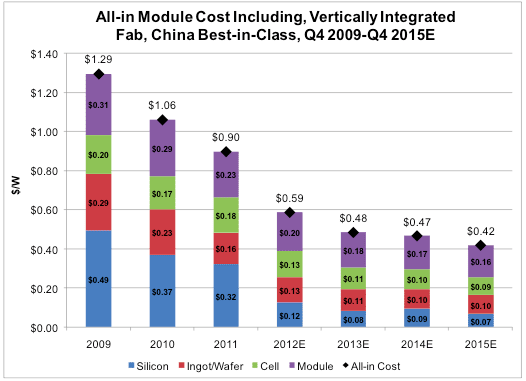One of the most common misconceptions about the global solar PV market is that is it the massive oversupply that is driving the bulk of technology cost reductions, and that these cost cuts will evaporate once the market has reached some sort of equilibrium.
Nothing could be further from the truth. As we have remarked before, the intense competition in the market is sparking remarkable innovation and efficiencies in the manufacturing process.
Last July, we noted how Greentech Media was heralding the arrival of US50c/Watt solar modules by 2015 – a development that would likely herald the arrival of parity between the cost of fossil fuels and utility scale solar in the US, China and India.
Six months later, Greentech Media have already cut that forecast for solar modules by 18 per cent, and brought forward the time interval by a year. According to research published overnight, the group is now forecasting the price of conventional silicon based solar modules to fall to US42c/Watt by 2015.
“Between 2009 and 2012, leading “best-in-class” Chinese c-Si solar manufacturers reduced module costs by more than 50 per cent,” it notes. And in the next three years, those players — companies like Jinko, Yingli, Trina and Renesola — are on a path to lower costs by another 30 percent.
It provides this chart below, which compares to the one we published last July. As you can see, costs have been shaved off each pricing component.

“Clearly, the magnitude of cost reductions will be less than in previous years. But we still do see potential for significant cost reductions. Going from 53 cents to 42 cents is noteworthy,” says Shayle Kann, vice president of research at GTM Research.
Greentech Media notes that there is still plenty of innovation in manufacturing processes – including new sawing techniques, thinner wafers, conductive adhesives, and frameless modules — and manufacturers will be able to squeeze more costs. Hence the focus on the “balance of system” cost issues identified by US Energy Secretary Stephen Chu, both in the article mentioned above, and in his recent parting letter to the Department of Energy, where he predicted solar PV would soon be cheaper than coal or gas-fired generation.
Even Mukesh Ambani, the chairman of Reliance Industries – the owner of the world’s largest oil refinery and the largest private company in India – said on Sunday that solar power will be at the core of the shift in future source of energy needs from hydrocarbons to renewables.
“We will transit from hydrocarbon presence which is coal, oil and natural gas over the next many decades into a fully renewable, sustainable future and the solar really will be at the heart of it,” Ambani said in an interview to CNN International.Reliance already has a solar division that was established to bring solar energy systems and solutions primarily to remote and rural areas.








